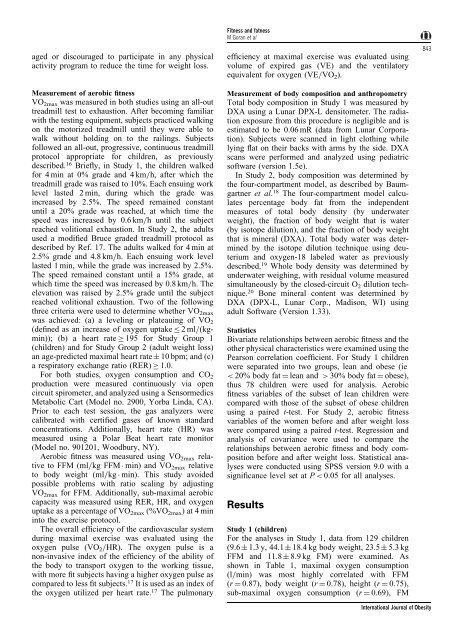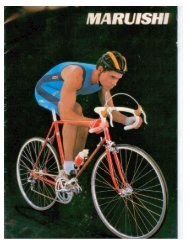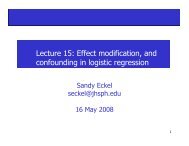Total body fat does not influence maximal aerobic capacity
Total body fat does not influence maximal aerobic capacity
Total body fat does not influence maximal aerobic capacity
Create successful ePaper yourself
Turn your PDF publications into a flip-book with our unique Google optimized e-Paper software.
aged or discouraged to participate in any physical<br />
activity program to reduce the time for weight loss.<br />
Measurement of <strong>aerobic</strong> ®tness<br />
VO2max was measured in both studies using an all-out<br />
treadmill test to exhaustion. After becoming familiar<br />
with the testing equipment, subjects practiced walking<br />
on the motorized treadmill until they were able to<br />
walk without holding on to the railings. Subjects<br />
followed an all-out, progressive, continuous treadmill<br />
protocol appropriate for children, as previously<br />
described. 16 Brie¯y, in Study 1, the children walked<br />
for 4 min at 0% grade and 4 km=h, after which the<br />
treadmill grade was raised to 10%. Each ensuing work<br />
level lasted 2 min, during which the grade was<br />
increased by 2.5%. The speed remained constant<br />
until a 20% grade was reached, at which time the<br />
speed was increased by 0.6 km=h until the subject<br />
reached volitional exhaustion. In Study 2, the adults<br />
used a modi®ed Bruce graded treadmill protocol as<br />
described by Ref. 17. The adults walked for 4 min at<br />
2.5% grade and 4.8 km=h. Each ensuing work level<br />
lasted 1 min, while the grade was increased by 2.5%.<br />
The speed remained constant until a 15% grade, at<br />
which time the speed was increased by 0.8 km=h. The<br />
elevation was raised by 2.5% grade until the subject<br />
reached volitional exhaustion. Two of the following<br />
three criteria were used to determine whether VO2max<br />
was achieved: (a) a leveling or plateauing of VO2<br />
(de®ned as an increase of oxygen uptake 2ml=(kgmin));<br />
(b) a heart rate 195 for Study Group 1<br />
(children) and for Study Group 2 (adult weight loss)<br />
an age-predicted <strong>maximal</strong> heart rate 10 bpm; and (c)<br />
a respiratory exchange ratio (RER) 1.0.<br />
For both studies, oxygen consumption and CO 2<br />
production were measured continuously via open<br />
circuit spirometer, and analyzed using a Sensormedics<br />
Metabolic Cart (Model no. 2900, Yorba Linda, CA).<br />
Prior to each test session, the gas analyzers were<br />
calibrated with certi®ed gases of known standard<br />
concentrations. Additionally, heart rate (HR) was<br />
measured using a Polar Beat heart rate monitor<br />
(Model no. 901201, Woodbury, NY).<br />
Aerobic ®tness was measured using VO2max relative<br />
to FFM (ml=kg FFM min) and VO2max relative<br />
to <strong>body</strong> weight (ml=kg min). This study avoided<br />
possible problems with ratio scaling by adjusting<br />
VO2max for FFM. Additionally, sub-<strong>maximal</strong> <strong>aerobic</strong><br />
<strong>capacity</strong> was measured using RER, HR, and oxygen<br />
uptake as a percentage of VO 2max (%VO 2max) at 4 min<br />
into the exercise protocol.<br />
The overall ef®ciency of the cardiovascular system<br />
during <strong>maximal</strong> exercise was evaluated using the<br />
oxygen pulse (VO2=HR). The oxygen pulse is a<br />
non-invasive index of the ef®ciency of the ability of<br />
the <strong>body</strong> to transport oxygen to the working tissue,<br />
with more ®t subjects having a higher oxygen pulse as<br />
compared to less ®t subjects. 17 It is used as an index of<br />
the oxygen utilized per heart rate. 17 The pulmonary<br />
Fitness and <strong>fat</strong>ness<br />
M Goran et al<br />
ef®ciency at <strong>maximal</strong> exercise was evaluated using<br />
volume of expired gas (VE) and the ventilatory<br />
equivalent for oxygen (VE=VO 2).<br />
Measurement of <strong>body</strong> composition and anthropometry<br />
<strong>Total</strong> <strong>body</strong> composition in Study 1 was measured by<br />
DXA using a Lunar DPX-L densitometer. The radiation<br />
exposure from this procedure is negligible and is<br />
estimated to be 0.06 mR (data from Lunar Corporation).<br />
Subjects were scanned in light clothing while<br />
lying ¯at on their backs with arms by the side. DXA<br />
scans were performed and analyzed using pediatric<br />
software (version 1.5e).<br />
In Study 2, <strong>body</strong> composition was determined by<br />
the four-compartment model, as described by Baumgartner<br />
et al. 18 The four-compartment model calculates<br />
percentage <strong>body</strong> <strong>fat</strong> from the independent<br />
measures of total <strong>body</strong> density (by underwater<br />
weight), the fraction of <strong>body</strong> weight that is water<br />
(by isotope dilution), and the fraction of <strong>body</strong> weight<br />
that is mineral (DXA). <strong>Total</strong> <strong>body</strong> water was determined<br />
by the isotope dilution technique using deuterium<br />
and oxygen-18 labeled water as previously<br />
described. 19 Whole <strong>body</strong> density was determined by<br />
underwater weighing, with residual volume measured<br />
simultaneously by the closed-circuit O2 dilution technique.<br />
20 Bone mineral content was determined by<br />
DXA (DPX-L, Lunar Corp., Madison, WI) using<br />
adult Software (Version 1.33).<br />
Statistics<br />
Bivariate relationships between <strong>aerobic</strong> ®tness and the<br />
other physical characteristics were examined using the<br />
Pearson correlation coef®cient. For Study 1 children<br />
were separated into two groups, lean and obese (ie<br />
< 20% <strong>body</strong> <strong>fat</strong> ˆ lean and > 30% <strong>body</strong> <strong>fat</strong> ˆ obese),<br />
thus 78 children were used for analysis. Aerobic<br />
®tness variables of the subset of lean children were<br />
compared with those of the subset of obese children<br />
using a paired t-test. For Study 2, <strong>aerobic</strong> ®tness<br />
variables of the women before and after weight loss<br />
were compared using a paired t-test. Regression and<br />
analysis of covariance were used to compare the<br />
relationships between <strong>aerobic</strong> ®tness and <strong>body</strong> composition<br />
before and after weight loss. Statistical analyses<br />
were conducted using SPSS version 9.0 with a<br />
signi®cance level set at P < 0.05 for all analyses.<br />
Results<br />
Study 1 (children)<br />
For the analyses in Study 1, data from 129 children<br />
(9.6 1.3 y, 44.1 18.4 kg <strong>body</strong> weight, 23.5 5.3 kg<br />
FFM and 11.8 8.9 kg FM) were examined. As<br />
shown in Table 1, <strong>maximal</strong> oxygen consumption<br />
(l=min) was most highly correlated with FFM<br />
(r ˆ 0.87), <strong>body</strong> weight (r ˆ 0.78), height (r ˆ 0.75),<br />
sub-<strong>maximal</strong> oxygen consumption (r ˆ 0.69), FM<br />
843<br />
International Journal of Obesity




